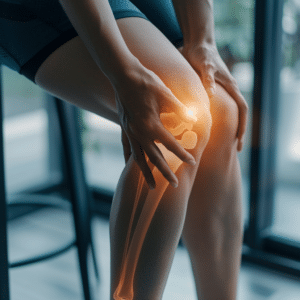Uncovering the Reasons: Why Is There So Much Pain After Knee Replacement?
Last updated Wednesday, September 18th, 2024

Experiencing pain after knee replacement might seem counterintuitive to what’s supposed to be a healing procedure. Why is there so much pain after knee replacement? This article cuts through the confusion to address the surgical, physical, and psychological factors influencing your recovery pain, aiming to arm you with knowledge for a more informed and comfortable healing journey.
Key Takeaways
- Post-knee replacement discomfort can arise from acute postoperative pain, chronic pain challenges, and activity-related pain, with chronic issues affecting up to 20% of patients.
- Surgical factors like implant positioning, nerve damage, and tissue trauma are key contributors to postoperative pain following knee replacement surgery.
- Rehabilitation, patient compliance, and individualized physical therapy are crucial for recovery and managing pain after knee surgery, although complications can occur if not tailored to the patient’s limitations.

Get Your FREE Case Review,
In Person or Virtually Online
Understanding Post-Knee Replacement Discomfort
Like a symphony with an array of instruments, post-knee replacement discomfort has many components. Acute postoperative pain, chronic pain difficulties, and activity-related pain all play their part in the patient’s experience.
Why does this happen? Here’s an explanation.
Acute Postoperative Pain
Imagine the body as a construction site. Surgery is a major renovation project, and acute postoperative pain is the body’s initial reaction to this upheaval. Pain relief strategies, like the orchestra conductor, help manage this process, allowing a harmonious recovery.
Chronic Pain Challenges

- inflammation
- infection
- nerve damage
- incorrect joint positioning
Furthermore, chronic pain isn’t just physical. It’s a thief, robbing patients of their quality of life. It’s a chameleon, disguising itself as complex regional pain syndrome, functional limitations, depression, social isolation, and more.
But, with a multidisciplinary approach, the grip of chronic pain can be loosened.
Activity-Related Pain
Picture this: you’ve just gotten a new car. It’s going to take some time to break it in, right? Similarly, activity-related pain is expected during the rehabilitation process, as the body adapts to the new knee joint. This discomfort should generally decrease over time as the body adjusts.
Nonetheless, if the ongoing pain remains consistent or even escalates, it could signal potential complications. Under such circumstances, immediate consultation with healthcare professionals is advised. Like a skilled mechanic, they can identify and address the issues causing the persistent discomfort.
The Role of Surgical Factors in Post-Knee Replacement Pain
Surgery, like a master artist, intricately shapes the outcome of a total knee replacement surgery, also known as knee arthroplasty or simply knee surgery. How the implant is positioned, the potential nerve damage, and tissue trauma all wield their brushes on the canvas of postoperative pain.
Implant Positioning and Fit
The precision of the artist’s strokes matters. Implant positioning is one such stroke, crucial to replicating the natural biomechanics of the knee. A misaligned implant can lead to a distorted masterpiece, disrupting ligament strains, and resulting in postoperative pain.
Nerve Damage and Healing
Surgical nerve damage is akin to an unexpected splash of paint, disrupting the intended image. Damage to nerves during surgery can lead to painful neuromas, reducing the range of motion of the knee, and impacting the patient’s recovery and comfort.
Tissue Trauma and Inflammation
Like an unavoidable spill, tissue trauma and inflammation are natural responses to surgical intervention. These elements can contribute to the overall picture of post-operative pain, but understanding and managing them can bring harmony back to the canvas.
Rehabilitation and Its Impact on Knee Pain
Consider rehabilitation as a tune-up, which is fundamental in managing post-surgery knee pain. It’s the physical therapy, patient compliance, and recovery time that keep your new knee running smoothly.
Physical Therapy’s Role
Think of physical therapy as a fitness coach for your new knee. It’s all about balance and strength, targeting range of motion, muscle strengthening, and balance. By tailoring exercises to individual patient needs, physical therapy enhances the performance of your knee, contributing to less pain.
Patient Compliance and Recovery Time
Just like a well-maintained car runs smoothly, a new knee also functions better when patients adhere to rehabilitation protocols. Sticking to the prescribed exercise regimens accelerates recovery and reduces pain, ultimately leading to a smoother ride.
Rare Complications from Rehab
Nonetheless, just like any tune-up, rehabilitation can occasionally encounter issues. Complications such as exacerbation of pain or injury can arise if exercises are not properly tailored to patient’s limitations.
It’s like revving a cold engine; it can lead to more harm than good.
Biological Responses to Knee Replacement Surgery
Just like weather patterns, biology too can be unpredictable at times. The body’s responses to knee replacement surgery, like immune reactions to implant materials, bone health, and blood clots, can all impact the forecast of postoperative pain.
Immune System Reaction to Implant Materials
The immune system, like a vigilant security guard, can react to foreign materials, including knee replacements. This response can trigger symptoms like:
- itching
- knee pain
- skin rashes
- joint stiffness
- swelling
Adding a stormy element to the postoperative weather.
Bone Health and Integration
Comparable to the foundation of a house, bone health and integration are essential for the stability of the implant. Compromised bone quality or extensive bone loss can shake this foundation, leading to increased postoperative pain.
Blood Clots and Circulation Issues
Circulation issues, like traffic jams, can cause severe disturbances. Blood clots and impaired circulation can cause severe pain and negatively impact the smooth flow of recovery.
Psychological Factors Affecting Pain Perception
Just as a powerful radio tunes into different frequencies, the mind also tunes into varying pain perceptions. Psychological factors like anxiety and depression can affect this tuning, amplifying the volume of pain signals.
Depression and Anxiety’s Role in Pain
Depression and anxiety, like static on a radio, can interfere with pain management. Addressing these mental health issues can help fine-tune the perception of pain, improving the overall reception of recovery signals and the effectiveness of pain medication.
Coping Mechanisms and Support
Finally, coping mechanisms and support networks are like the volume control and antenna of our radio. They help manage the reception and volume of pain signals, contributing to a clearer broadcast of recovery.
Addressing Persistent Pain After Knee Replacement
What if the persistent pain continues like a distressing tune on repeat? In such cases, further steps like consulting your orthopedic surgeon, considering revision surgery, or exploring alternative pain management strategies may be helpful.
When to Consult Your Orthopedic Surgeon
As you would call a technician when your radio malfunctions, so should you consult your orthopedic surgeon when persistent pain continues. They can help identify the causes of the persistent discomfort and propose solutions.
Potential Revision Surgery
Sometimes, a radio might need an overhaul. Similarly, when persistent pain is related to the implant, revision surgery might be considered. However, this should be a last resort, only undertaken after accurate diagnosis of the pain source.
Alternative Pain Management Strategies
Just like exploring different radio models or brands, alternative pain management strategies, such as hydrodissection and cognitive-behavioral therapy, can offer a different tune for reducing pain for patients with preoperative conditions. Further research into these methods and surgical techniques may provide even more effective solutions for pain management.
Frequently Asked Questions
Is it normal to have excruciating pain after knee replacement surgery?
It is normal to experience general pain in the knee after replacement surgery, which usually decreases within the initial 2-3 weeks and can be managed with medications like non-steroidal anti-inflammatory drugs or short-term opioids.
How long does pain last after total knee replacement?
Pain after total knee replacement surgery typically decreases in the first 2-3 weeks as part of the recovery process.
How does implant positioning affect postoperative pain?
Incorrect implant positioning can lead to increased ligament strains and disrupted knee movement, which can result in postoperative pain.
How important is patient compliance during rehabilitation?
Patient compliance during rehabilitation is crucial for speeding up recovery and minimizing pain. It’s important to adhere to prescribed exercise regimens.
How can immune system reactions to implant materials affect postoperative pain?
Immune system reactions to implant materials can cause symptoms such as itching, pain, skin rashes, joint stiffness, and swelling, potentially leading to postoperative pain.

